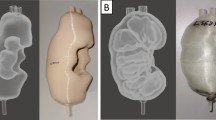Abstract
When quantification of renal activity is performed by planar imaging, many correction factors must be considered. To obtain quantitative renal images and renogram, we have examined our proposed method by using the organ volume for scatter, attenuation, and background activity, and the interporative background subtraction (IBS) technique in phantom and clinical studies. A renal phantom study was performed by varying the renal depth from 3 to 11 cm and the kidney-to-background activity concentration ratio from 5 to 80. Planar images were properly corrected for scatter, attenuation and background activity by our method and the corrected images were compared with the images obtained by the conventional method for the estimation of true renal activity. Clinical Tc-99m DTPA dynamic data for both a good and a poor renal function were also corrected by our method and volume-corrected renograms were obtained. For the phantom study, depth-independent images were obtained and these images gave a good estimation of the true count rate. In the clinical study, the conventional renogram was especially modified to allow for oversubtraction of background counts in the early phase (0–4 min). In conclusion, our proposed correction method can assess renal function qualitatively and quantitatively in both static and dynamic planar renal imaging.
Similar content being viewed by others
References
Gates GF. Glomerular filtration rate: estimation from fractional renal accumulation of Tc-99m DTPA (stanous).AJR 138: 565–570, 1982.
Gates GF. Split renal function testing using Tc-99m DTPA: A rapid technique for determining deferential glomerular filtration.Clin Nucl Med 8: 400–407, 1983.
Kojima A, Takaki Y, Matsumoto M, Tomiguchi S, Hara M, Shimomura O, et al. A preliminary phantom study on a proposed model for quantification of renal planar scintigraphy.Med Phys 20: 33–37, 1993.
Takaki Y, Kojima A, Tsuji A, Nakashima R, Tomiguchi S, Takahashi M. Quantification of renal uptake of technetium-99m-DTPA using planar scintigraphy: a technique that considers organ volume.J Nucl Med 34: 1184–1189, 1993.
Goris ML, Daspit SG, McLaughlin P, Kriss JP. Interpolative background subtraction.J Nucl Med 17: 744–747, 1976.
Siegel JA. The effect of source size in the buildup factor calculation of absolute volume determination.J Nucl Med 26: 1319–1322, 1985.
Conrad GR, Wesolowski CA. Avoidance of errors related to renal depth during radionuclide evaluation of renal perfusion.Clin Nucl Med 13: 721–726, 1988.
Brown NJG. The application of interpolative background subtraction to Tc-99m DTPA gamma camera renography data.In: Joekes AM, et al., eds.Radionuclide in Nephrography. London: Academic Press/Grune and Stratton, pp. 113–118, 1982.
Hurwitz GA, Champagne CL, Gravelle DR, Smith FJ, Powe JE. The variability of processing of technetium-99m DTPA renography: role of interpolative background subtraction.Clin Nucl Med 18: 273–277, 1993.
Piepsz A, Dobbeleir A, Ham HR. Background determination for99mTc DTPA renal studies: a comparison between interpolative background subtraction and surface ratio method.Nucl Med Commun 4: 276–281, 1983.
Sennewald K, Taylor A. A pitfall in calculating differential renal function in patients with renal failure.Clin Nucl Med 18: 377–381, 1993.
Piepsz A, Dobbeleir A, Erbsmann F. Measurement of separate kidney clearance by means of99mTc-DTPA complex and a scintillation camera.Eur J Nucl Med 2: 173–177, 1977.
Piepsz A, Denis R, Ham HR, Doebbeleir A, Schulman C, Erbsmann F. A simple method for measuring separate glomerular filtration rate using a single injection of99mTc-DTPA and the scintillation camera.J Pediatr 93: 769–774, 1978.
Shore RM, Koff SA, Mentser M, Hayes JR, Smith SP, Smith JP, et al. Glomerular filtration rate in children: determination from the Tc-99m-DTPA renogram.Radiology 151: 627–633, 1984.
Kenny RW, Ackery DM, Fleming JS, Goddard BA, Grant RW. Deconvolution analysis of the scintillation camera renogram.Br J Radiol 48: 481–486, 1975.
Diffey BL, Hall FM, Corfield JR. The99mTc-DTPA dynamic renal scan with deconvolution analysis.J Nucl Med 17: 352–355, 1976.
Piepsz A, Ham HR, Erbsmann F, Hall M, Diffey BL, Goggin MJ, et al. A co-operative study on the clinical value of dynamic renal scanning with deconvolution analysis.Br J Radiol 55: 419–433, 1982.
Gullquist RR, Fleming JS. Error analysis by simulation studies in renography deconvolution.Phys Med Biol 32: 383–395, 1987.
Author information
Authors and Affiliations
Rights and permissions
About this article
Cite this article
Kojima, A., Takaki, Y., Tsuji, A. et al. Quantitative renography with the organ volume method and interporative background subtraction technique. Ann Nucl Med 10, 401–407 (1996). https://doi.org/10.1007/BF03164801
Received:
Accepted:
Issue Date:
DOI: https://doi.org/10.1007/BF03164801




